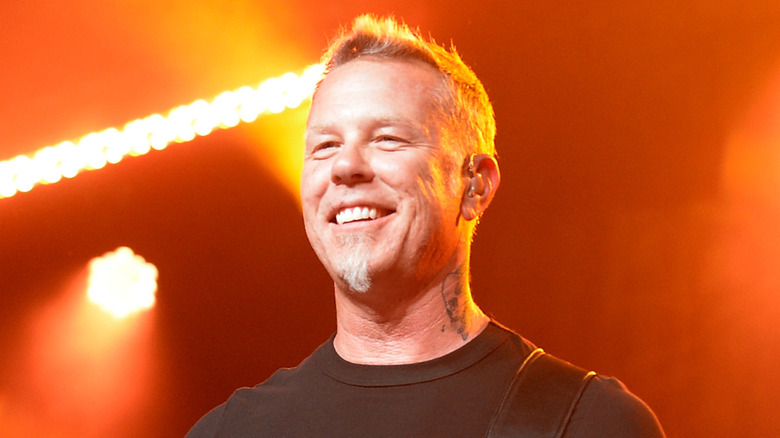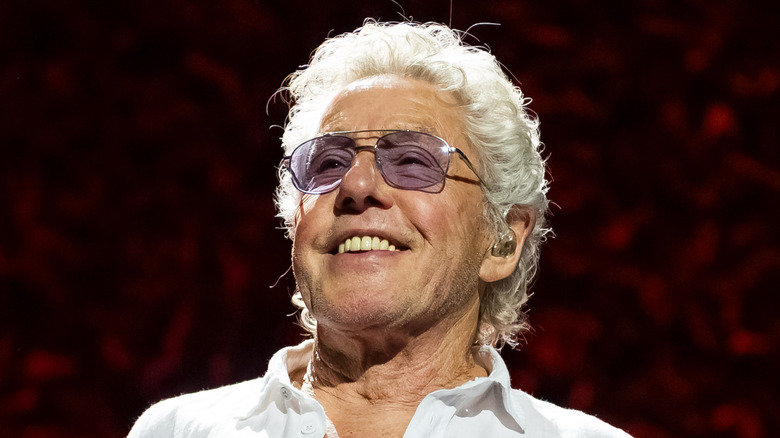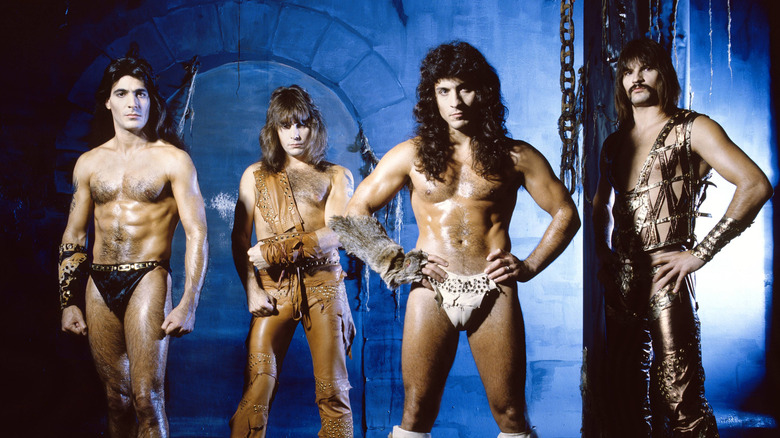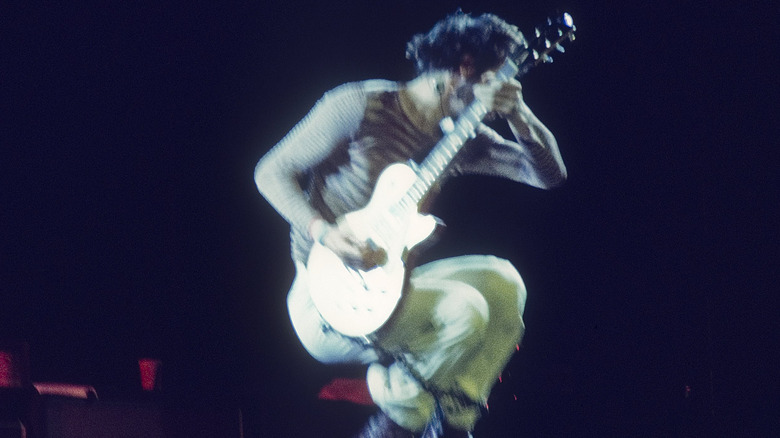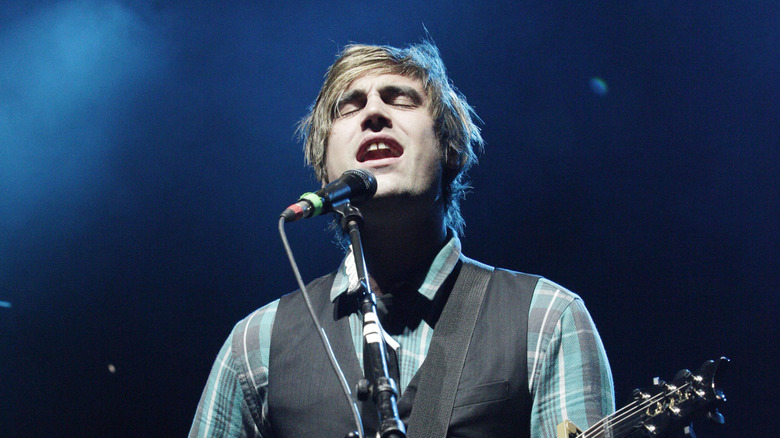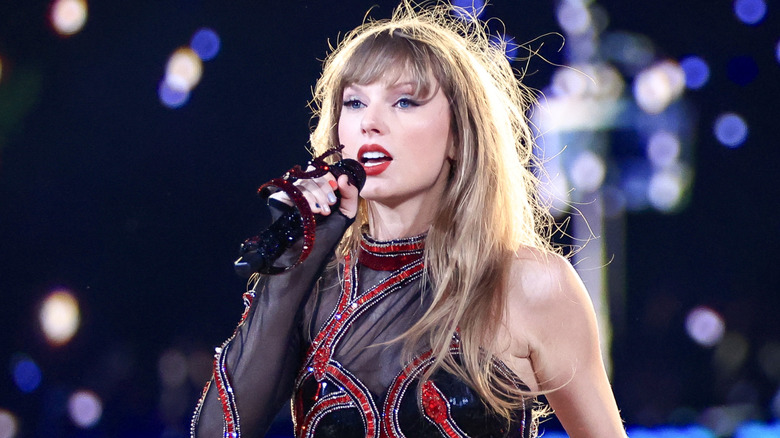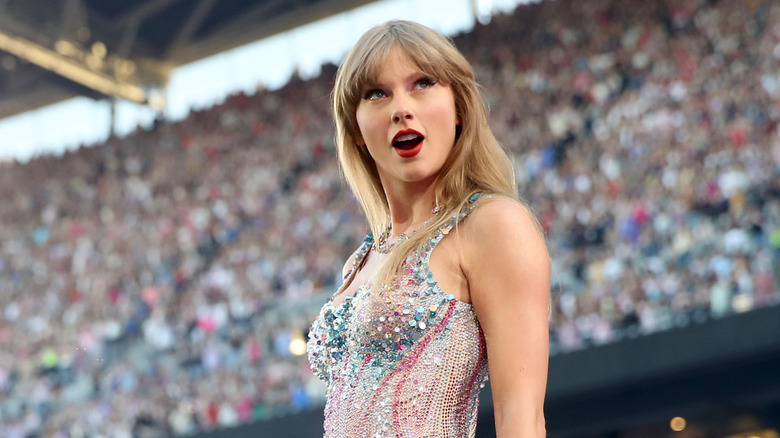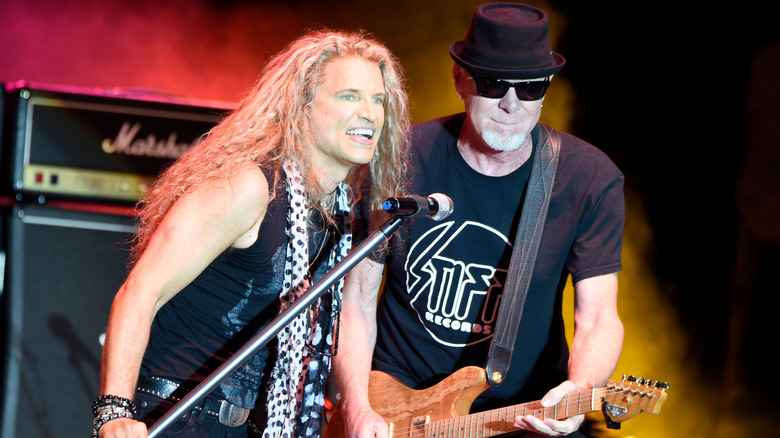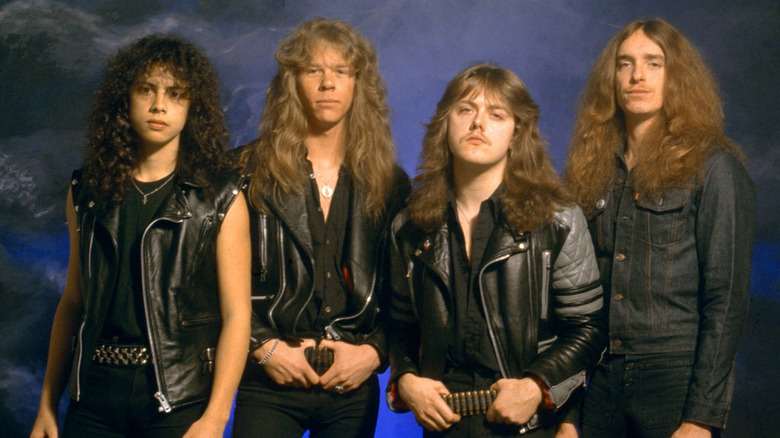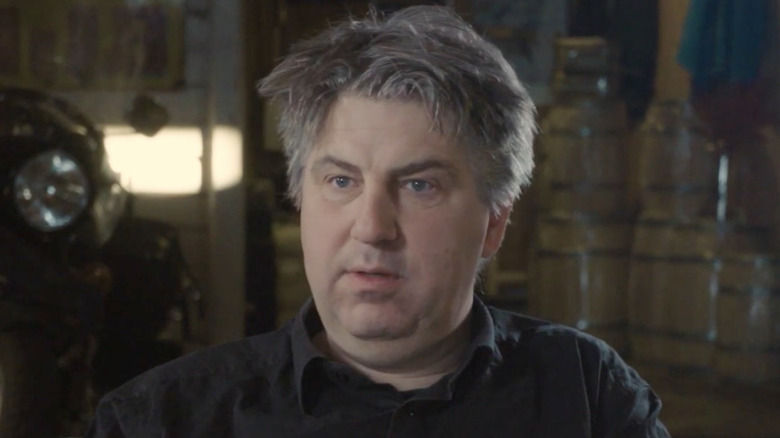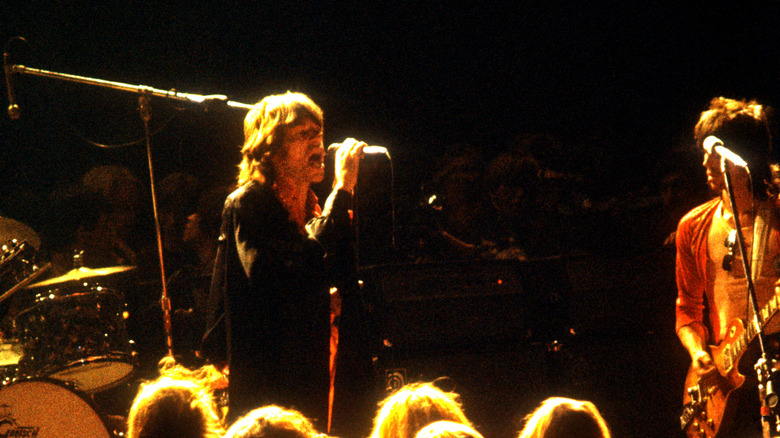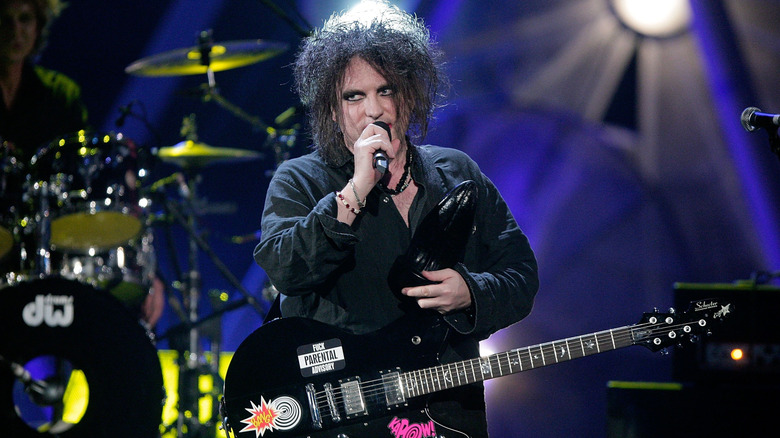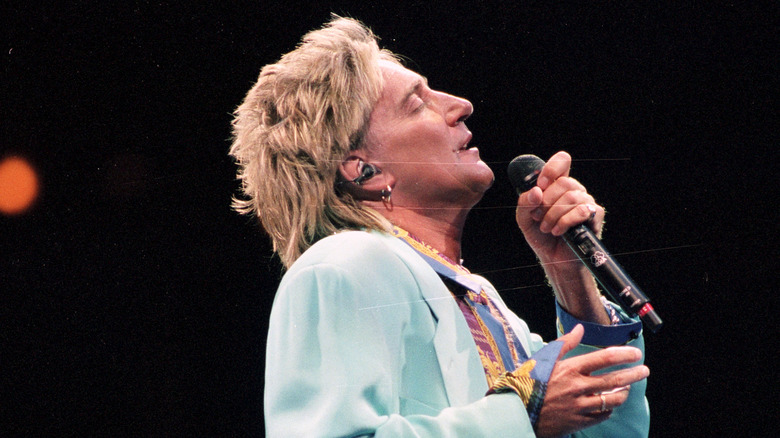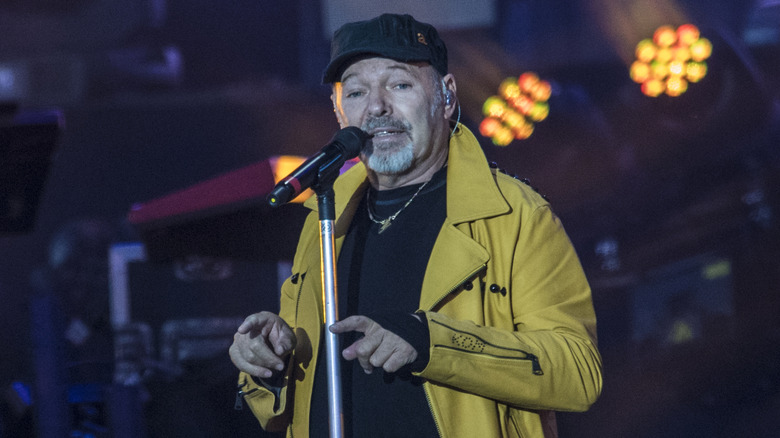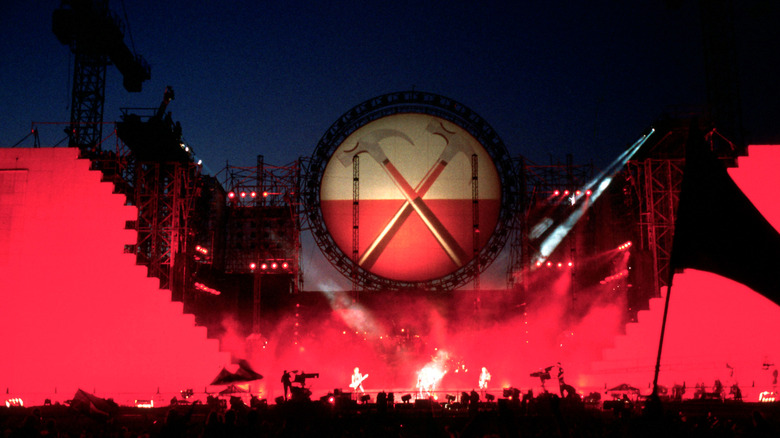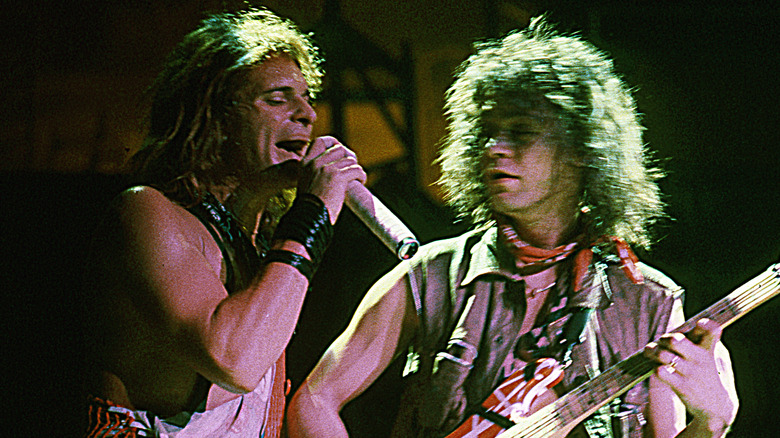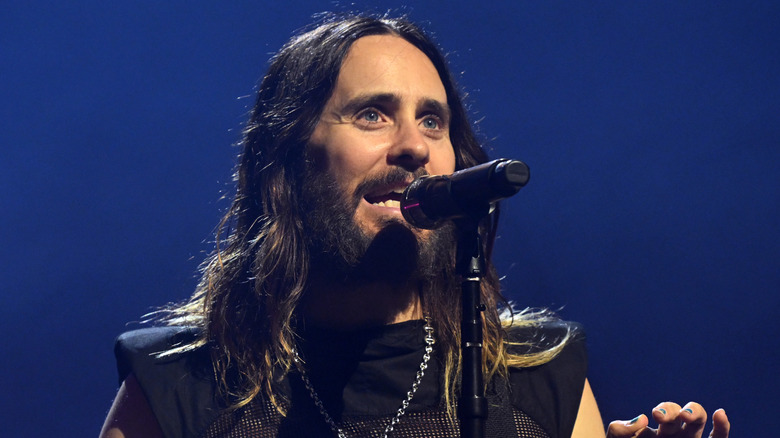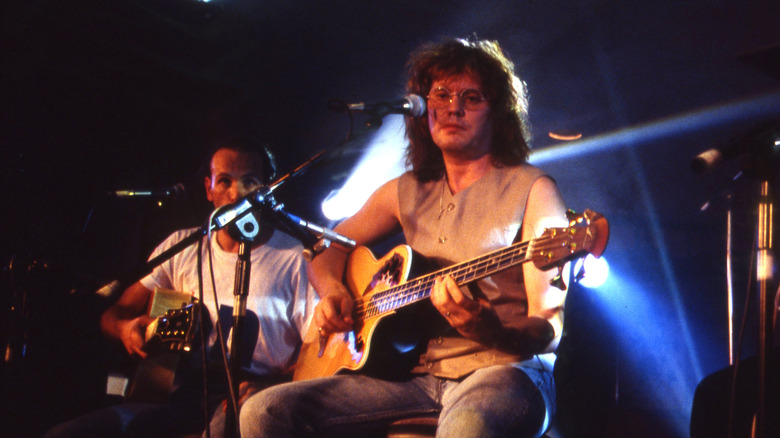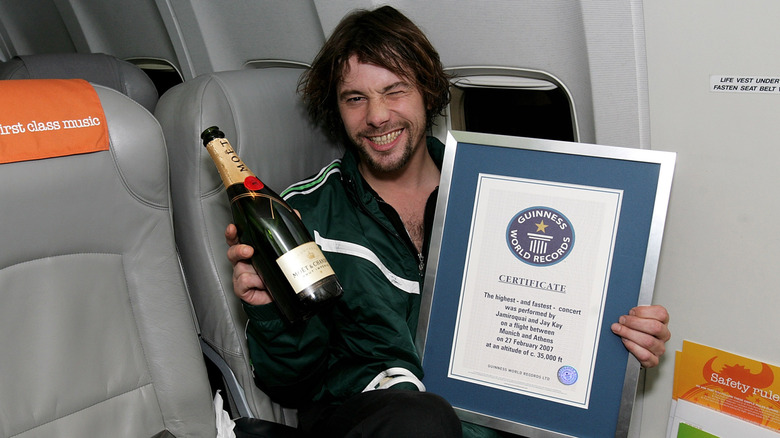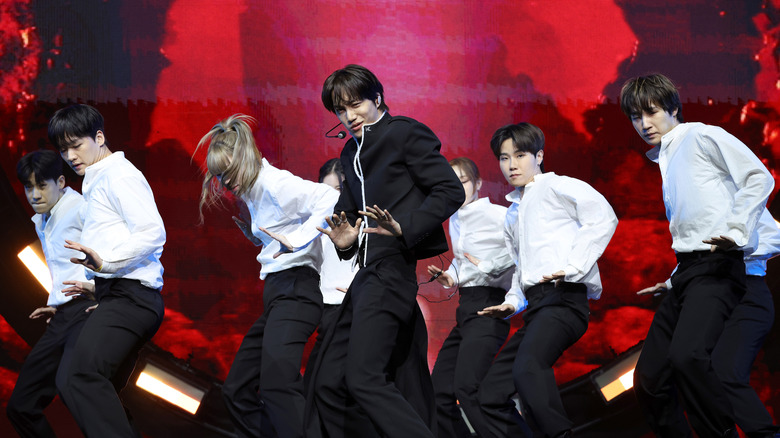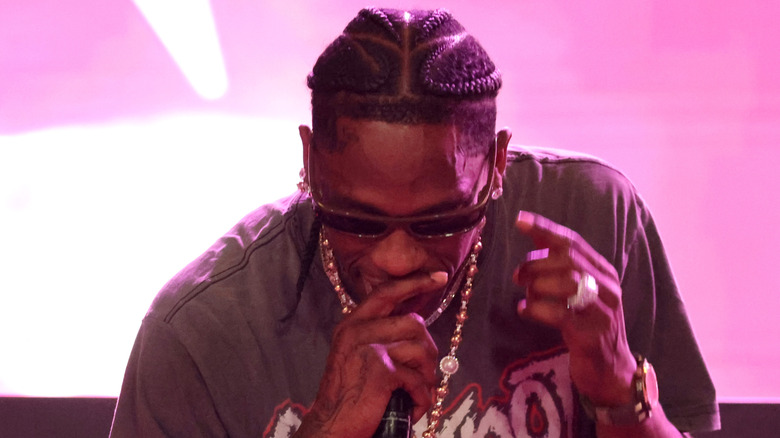Musicians Who Shattered World Records While On Tour
By its very nature, a rock concert, or a big and glitzy show by a pop star, is a massive deal and a special occasion. Everything about a musical performance in an arena, stadium, amphitheater, or even a nightclub is designed to dazzle and delight the appreciative fans, who likely paid a not insignificant amount of money to attend. Even the most creatively and commercially dominant musical acts can only get out on the road to play so many shows, and generally not more than one or two in a city. A night out on the town, hearing the well-known hits, along with dancing, stage banter, pyrotechnics, and the collective experience of enjoying an act that everyone likes, make it all an unforgettable experience.
But sometimes, a concert is even more special. Bands, singers, and performers whose job it is to perform in front of adoring audiences once in a while literally make history, doing one thing better, bigger, or more impressively than anyone else could ever do it. Here are the musicians who, in the course of touring and playing concerts, went ahead and set new world records.
The band that played the shortest concert
In February and March of 2007, the Who played 14 engagements in cities around North America, something of a warm-up to a 28-date summer tour of European festivals. One such spot on the tour, staged to promote the Who's 2006 album "Endless Wire," was a concert at the Ford Amphitheater in Tampa. The band took the stage in front of about 9,000 screaming fans and immediately launched into one of its most famous songs, and its first ever hit single, the 1965 track "I Can't Explain."
The Who didn't get much farther than the song's distinctive opening guitar lick. Singer Roger Daltrey, who was once kicked out of the Who, realized a little late that his diagnosed case of bronchitis was too severe to allow him to sing, let alone talk. He didn't sing a note, and guitarist Pete Townshend cut himself off mid-riff and announced that the concert was over, on account of Daltrey's vocal impairment. The Who played a makeup show in Tampa 11 days later, but that first attempt was later officially recognized by Guinness World Records as the shortest music concert of all time. It ended after just 13 seconds.
The rock band that played the longest concert
The bizarre history of heavy metal included a commercial peak in the 1980s, and that's when Manowar garnered some attention. Manowar never sold as many records or scored as many hits as its peers, preferring to play what it said was more authentic: classically-influenced guitar riffs played loud, fast, and hard, and songs about death, violence, fantasy, and mythology. Manowar, well known for dressing publicly like warriors in little more than loincloths and leather vests, churned out headbanger-friendly LPs with regularity from the early 1980s until the 2010s, building up a massive back catalog of cuts from albums with names like "Into Glory Ride," "Sign of the Hammer," "Battle Hymns," and "The Triumph of Steel."
All that material meant that Manowar would easily have enough songs to play were it to ever try to set a world record for the longest-lasting rock concert of all time. In July 2008, Manowar was among the bands on the bill of the Kaliakra Rock Festival, held in Kavarna, Bulgaria. Its set list included upwards of 40 songs of original material and a few stray covers. That was more than enough to get Manowar's total stage performance time to five hours and one minute — easily setting the record for the longest concert ever.
The band whose concert was the loudest ever
The 1970s was the age of hard rock, and what would come to be known as classic rock and bands with shredding guitarists, wailing lead vocals, and thundering drummers could fill arenas and stadiums packed with walls of speakers. This period was also the peak of the commercial, critical, and cultural impact of the Who, which enjoyed a reputation as one of the loudest bands around, if not the loudest band, traversing the rock n' roll touring circuit.
In 1976, the Who decided it wanted to differentiate itself from its peers and make it official. On May 31, 1976, the Who was scheduled to perform at The Valley, an outdoor stadium in the Charlton area of London. Authorities from Guinness World Records were invited, and they brought their testing equipment and measured the band's output, which at its loudest, registered at 126 decibels from a space of about 100 feet away from speakers. That's slightly noisier than thunder, but for a sustained period of time, enough to cause permanent and significant hearing damage to attendees. It was more than enough to earn the Who the title of "World's Loudest Band."
The singer who staged the coldest concert
The pop-punk band Busted sold millions of albums and scored numerous No. 1 hits in its native U.K. in the early 2000s. Singer Charlie Simpson simultaneously played with the very heavy Fightstar and then became a solo act in the acoustic, singer-songwriter vein. After touring in the wake of his 2011 album "Young Pilgrim," Simpson arranged for a special, one-off show in Oymyakon, a tiny town in the northern Russian region of Siberia. At the time of the November 24, 2012, concert, Oymyakon didn't offer electricity or running water to its 472 residents, who lived among extremely cold regular temperatures. That was the whole idea: Simpson wanted to play the coldest concert of all time.
"The gig is by far one of the biggest challenges of my career, but I'm really excited to get out there and see a part of our planet that very few people will ever get to visit," Simpson told NME. "It's not really an option to play my guitar wearing gloves, so I just hope my fingers don't freeze."
Adhering to Guinness's rules that the show had to last for at least 15 minutes in front of at least 10 spectators, Simpson pulled off the feat and was proclaimed by the record-keeping organization to have played the "Coldest Concert." The temperature at the time: minus 30 degrees Celsius, or minus 22 degrees Fahrenheit.
The artist who performed the hottest concert
There's no official record for "most chaotic concert" or "concert where the most people felt their health, safety, and lives were in danger." Taylor Swift's November 2023 show in Brazil did, however, register as what was likely the hottest outdoor concert in history.
Swift's concert at Nilton Santos Stadium in Brasilia, Brazil, was her first date in the country on her monumentally lucrative "The Eras Tour," so the stadium was packed with fans. The outdoor temperature was already well above 100 degrees Fahrenheit, and the environment was made all the hotter by tightly packed crowds of people who had been prevented from bringing in outside water, personal fans, and shade umbrellas. One fan, 23-year-old Benevides Machado fainted during Swift's performance of "Cruel Summer" and died at a hospital from cardiorespiratory arrest; 1,000 others received medical assistance for passing out and dehydration. At the hottest point in the day, the temperature hit 138 degrees Fahrenheit.
The act whose concert generated the most seismic activity
Lumen Field is home to the NFL's Seattle Seahawks, and it's also one of the largest concert venues in the Pacific Northwest. On July 22 and July 23, 2023, Taylor Swift performed at Lumen Field as part of her career retrospective "The Eras Tour." Both shows sold out and filled Lumen Field to its capacity, with 72,171 people attending the first show, and roughly the same on the second night. During both concerts, local earthquake researchers noticed an uptick in seismic activity in the exact area where Lumen Field stands. According to their equipment, an earthquake with a magnitude of 2.3 occurred during each of the Swift shows — and actually because of the Swift shows. "I collected about 10 hours of data where rhythm controlled the behavior. The music, the speakers, the beat. All that energy can drive into the ground and shake it," Western Washington University geology professor Jackie Caplan-Auerbach told CNN.
A Bruce Springsteen show in Barcelona in 2016, and a Garth Brooks event at Tiger Stadium in Louisiana in May 2022, both caused what looked like minor earthquakes to scientific equipment. But only Swift is listed by Guinness World Records for "greatest seismic activity caused by a music concert."
The band whose concert was the deadliest
Of the handful of times that fans died at concerts, the tragic events at a Great White show will go down in history as the most voluminous loss of life at a rock performance. A moderately popular band in the hair metal scene of the late 1980s and early 1990s for hits like "Once Bitten, Twice Shy," by the early 2000s, Great White was still around but playing small venues, like the West Warwick, Rhode Island club The Station. For its February 20, 2003 show, Great White's tour manager tried to re-create the band's big arena shows of yore by rigging up some stage pyrotechnics at the beginning of the set, which The Station management had actually forbidden on account of it being a fire hazard in such a small space. Sadly, and frighteningly, a fire immediately began and spread quickly.
As the room quickly filled with flames, the band left via a stage door. Four posted exits should've been ample to accommodate the 400 panicked Great White fans, but a bouncer disallowed use of the stage door used by the band, and two others had been quietly barricaded, leaving just one usable exit. Fans crushed up against each other in their haste, and many became trapped inside while the fire raged. When it was all over, 100 people died as a result of attending the Great White concert.
The first band to play every continent
Metallica emerged with its first album, "Kill 'Em All," in 1983, and made its aggressive, fast, and dark thrash metal into pop music. Extensively touring to serve its millions of fans around the world, Metallica was one of the biggest bands on the planet before and after the release of its blockbuster self-titled 1991 LP. There was so much global demand for Metallica that the band was able to systematically visit almost every populated corner of the world.
Including one which tragically contributed to the list of rock stars who died on tour, when bassist Cliff Burton perished in a bus crash, Metallica has staged concerts in all six of Earth's inhabited continents. It played its earliest shows in North America in 1982, then toured Europe for the first time in 1984, followed by Asia in 1986, Oceania in 1989, South America in 1999, and Africa in 2006.
On December 8, 2013, Metallica did what no other musical act has before or since. It played Antarctica, the icy, freezing landmass at the bottom of the planet that is only home to rotating teams of scientists and researchers. The band played a specially arranged 60-minute concert called "Freeze ' Em All" at the Carlini Station, in front of an audience of 120 resident scientists and flown-in contest winners. The band now appears in Guinness World Records for the accomplishment.
The musician who played the most concerts in 24 hours
A concert tour of more than five dozen gigs is a rigorous slog for almost any performer, even when the shows are spaced a day or two apart and played over the course of a couple of months in multiple cities. It's therefore especially impressive that Norwegian musician Helge Toft embarked on a 65-concert tour, which he completed over the span of just one day.
Along with his backing band composed of Jens Rimau, Paul Inge Vikingstad, and Anders Bjelland, Toft began his tour in Haugesund, Norway, on June 21, 2012. It stretched into the night and into the next day, when he was still playing in various clubs, halls, and other venues all in or near the city of Haugesund. Guinness World Records authorities verified the geographically minor but performatively major stunt and listed Toft in its books for holding the record of "Most concerts performed in 24 hours."
The singer who used the most languages used in one show
In August 2021, 16-year-old singer Suchetha Satish of India set a Guinness-recognized record for "Most languages sung in a concert." She performed in a total of 120 different languages over many hours, only to be bested by singer Manjushree Vasant Oak — with a 121-language concert — not long after. Satish is a climate change awareness advocate, and in November 2023, she took back her world record with an act of advocacy. In the lead-up to the COP 28, a climate change summit held in Dubai, Satish staged the "Concert for Climate" at the Indian Consulate Auditorium.
Across a nine-hour show, Satish sang in 140 distinct languages. That number was picked as a nod to the representatives of 140 nations set to attend the summit. The volume of language was picked to send a message that climate change is an issue that affects everyone on the planet.
The group that played the concert where the most babies were born
In one of the ugliest and darkest moments in rock history, tragedy marred the Rolling Stones' concert at Altamont. The December 6, 1969, outdoor festival-style show at the Altamont Speedway in Tracy, California, was headlined by the Rolling Stones after a long tour, and featured sets by several important bands of the late '60s, including Santana and Jefferson Airplane. Members of the Rolling Stones were active in organizing the concert, up to hiring individuals associated with the Hells Angels, a notorious biker gang, to work as the venue's security team. When the Rolling Stones closed out the show after sundown, Alan Passaro of the Hells Angels stabbed to death 18-year-old concertgoer Meredith Hunter right in front of the stage and without the band's knowledge.
While the Altamont festival is notorious for Hunter's death, it's less known for being the setting of a new world record. Over the course of the six-hour event, it was attended by about 300,000 people, not counting the four babies born at the event. That's how many expectant mothers delivered their newborns on the festival grounds, recognized by Guinness World Records as the "most births at a music concert."
The band that staged the concert with the most encores
Fans can come to rely on an encore of a song or two, or even a second bonus section of the concert. It's a bit of theater: the headliner pretends like the show is over, leaves the stage, and then returns, theoretically lured out by the continued applause of the audience. But classic goth-alternative band The Cure absolutely revels in the idea of the encore, so much so that on more than one occasion, it's set a Guinness World Records-authenticated record for returning to the stage after their shows more than any other act.
In August 2004, at the conclusion of its concert at the Everett Events Center near Seattle, the Cure came out for five encores, the equivalent of 12 songs. A week later, the Cure show at the Palacio de los Deportes in Mexico City also finished out with five encores that offered 14 songs. The third and last time that the Cure gave its fans five encores was to close out a show at Hezarfen Havaalani in Istanbul, Turkey, in September 2005. That time, the Cure played 15 songs after the concert was technically supposed to be over.
The singer who played the free show with the most attendees
The New Year's Eve festivities that occur on Rio de Janeiro's Copacabana Beach rank among the world's biggest celebrations of the year's end. For millions of Brazilians, it's an annual tradition to hit the oceanside to party, welcome the New Year with a grand fireworks display, and then enjoy a concert by an iconic act. In past years, Copacabana Beach has attracted the likes of Madonna, the Rolling Stones, and in 1994, Rod Stewart. One bonus of making the trek to the luxurious party hotspot: the A-lister concert is always free.
According to Guinness World Records, the attendance for Stewart's concert swelled because in 1994, Brazil was in the midst of a national celebration, having just won the FIFA World Cup after more than two decades of futility. While Guinness certified the December 31, 1994, Rod Stewart concert to have amassed the "largest attendance of a free concert," the organization, nor any other agency, could determine exactly how many people showed up to see the singer croon "Maggie May," "Have I Told You Lately," and "Da Ya Think I'm Sexy?" Estimates peg the figure at somewhere between 3.5 million and 4.2 million people, all watching along a 3-mile stretch of sandy beach.
The singer who performed in front of the most paying ticket-holders
Little-known outside of his home nation of Italy, Vasco Rossi is the most prominent rock star of all time in that country and its most dominant musical presence for the last four decades. He's sold 35 million copies of his albums, almost entirely in Italy and Switzerland, and Rossi and his music are so phenomenally and universally popular in Italy that people will pay a lot of money to see him perform live. His concerts can sell out his home country's biggest arenas and stadiums, and in 2017, he set a record for a ticketed rock concert.
That was Rossi's plan all along. He promoted his show at Enzo Ferrari Park in the city of Modena with the intent to set a record to play what would technically be the most-attended concert ever. After first offering tickets to fan club members and then to the general public, a total of 220,000 tickets were purchased and used. Add in another 5,000 tickets given out for free to special and certain audience members, and Rossi achieved his goal by performing in front of a record 225,173 fans.
The musician that played the concert with the most people onstage at once
An extremely ambitious, progressive, and forward-thinking work, Pink Floyd's "The Wall" began life as a double-length concept album released in 1979. Bassist Roger Waters led the development of the lyrics, music, and story, a dark and harrowing saga about abuse and trauma. It was adapted into a cult classic art film, and when Pink Floyd presented "The Wall" on tour in 1981 and 1982, a facade made up of 340 bricks was slowly built onstage over the first half of each show, then torn down at the end of the second half.
"The Wall" was transformed into physical art once more. After leaving Pink Floyd in the 1980s, Waters staged his concept album as a theatrical, musical event on Potsdamer Platz in Berlin in July 1990. The Berlin Wall, separating free West Berlin from communist East Berlin, had been torn down less than a year earlier, and it had stood right near where Waters and his guests performed. It's such a vast and sprawling area — the performance space was 551 feet long and 82 feet wide — that Waters could think big with his stagecraft. By the end of the show, the concert required the labors of 600 performers. The 200,000 or so spectators became part of the show, too, invited to help build up and tear down Waters' wall of 2,500 foam bricks, resulting in a world record for the number of performers in a concert.
The touring band with the longest list of demands
The legendarily rowdy Van Halen often went too far with its antics, and according to an urban legend, the hard rock band would supposedly destroy its dressing rooms or refuse to take the stage if the bowl of M&Ms it requested backstage included any brown ones. The truth of the matter is that '80s-era Van Halen really did request such adulterated pre-show candy, but for a good reason. In 1982, Van Halen issued a concert rider, a detailed list of requirements and precise instructions for promoters and arena staff contracted to stage the band's shows. More than 40 years later, and after inspiring countless other bombastic arena tours, Van Halen's rider is still the longest and most complicated, as certified by Guinness World Records.
That tour was one of the biggest and most elaborate rock tours ever attempted to that point, and to make sure all that gear, musical equipment, and stage effects devices were set up correctly by potentially inexperienced local crews in each stop, singer David Lee Roth concocted the exacting rider. If he went backstage and saw brown M&Ms, he'd instantly know that the staff hadn't thoroughly read the rider, and that it might not be safe to play the show.
The band that went on the longest individual concert tour
It's become common in the music industry for big-label acts to follow an album release cycle that lasts from about a year to 18 months. The band or singer records an album, tours to promote it, takes a break, and then gets back into the studio. Probably the most laborious part of that plan is the concert tour, which can last for the better part of a year.
The emo-goth-alternative rock band Thirty Seconds to Mars, best known for chart-topping 2000s hits like "Kings and Queens" and "From Yesterday," and for how its frontman is Oscar-winning movie star Jared Leto, made an even stronger commitment to the touring element. In November 2009, Thirty Seconds to Mars played the first shows in a road trip meant to promote its album "This is War." And then the band just kept playing concerts for well over two years; the group finished that tour with a show at the Hammerstein Ballroom in New York City in December 2011. With a total of 309 concerts played, Guinness World Records acknowledged Thirty Seconds to Mars for finishing the "longest concert tour by a rock band."
The group that played the most concerts on three continents in a day
In 1995, pop-hard rock band Def Leppard was already in the mood to reflect on its standing and legacy thanks to the release of a best-of album, "Vault: Def Leppard Greatest Hits 1980–1985." To promote the collection as well as itself, and to get the band's name etched into the annals of history, Def Leppard declared that it set a brand-new Guinness World Record by doing something that no other band had done before. The challenge: play three concerts in three different countries, all on different continents, and all on the same day.
Billed as "Vaulting the World" and "3 Continents in a Day," Def Leppard began the day of October 23, 1995, with a show in Tangier, Morocco, that started at just past midnight. After the hour or so performance, Def Leppard hopped a plane to travel from northern Africa to Europe, where it played a second gig in London. Then the group flew to Vancouver, in North America, and completed the trifecta of concerts at around 11:30 p.m., British Columbia time.
The band that played the show farthest from the ground
Cell phone company Sony Ericsson held a promotional contest that paid off in 2007, when 200 lucky winners were treated to a free concert. The band they got to see was jazz-funk-rock act Jamiroquai, popular throughout the '90s in the U.K. and best known in the U.S. for its trippy, MTV Video Music Award-winning video for its single "Virtual Insanity." It wasn't some regular, intimate concert experience, however. Sony Ericsson outfitted a plane with a small stage and took the contest winners up in the sky with Jamiroquai.
The prize flight flew attendees from Munich to Athens, and then back to the U.K. the next day after two Jamiroquai shows: one on the ground at a private party, and the other inside the airplane itself. Appropriately promoting the album "High Times," the show was one of the few attempts ever made to hold a concert in the sky, in the middle of a flight. When Jamiroquai started playing at 35,000 feet, it secured the group the Guinness World Record for "performance at the highest altitude."
The act whose concert sold out the fastest
A combination of performer charisma, precise choreography, and undeniably catchy hooks made the music made by South Korean boy bands, otherwise known as K-pop, a global phenomenon. One of the most successful bands in that genre is EXO, and nowhere is the group more popular than in its nation of origin. In 2014, EXO set out on its first-ever headlining concert tour, "From EXO #1: The Lost Planet," and tickets for the group's initial shows in the South Korean capital and largest city of Seoul went on sale on April 16 of that year. Offered exclusively by online company Gmarket, all tickets for the two shows scheduled to take place in late May were gone almost instantly, selling out in a record 1.47 seconds.
When EXO planned out its fourth tour, "EXO Planet #4 – The ElyXiOn" in 2017, it beat its own record for fastest concert sellout. All 67,000 tickets disappeared just 0.2 seconds after they went up for sale.
The artists whose concerts moved the most tour merchandise
Part of the experience of going to a gigantic concert is picking up a souvenir to prove and remember one's attendance. An abundance of fans paying a visit to the merch table or booth before, during, or after a show can bring in substantial revenue for the act in addition to ticket sales, and it can even generate a fortune. Singer-rapper Travis Scott's "Utopia-Circus Maximus" tour criss-crossed North America in 2023, and in a one-week period, he performed two shows at the American Airlines Center in Dallas, and two at Ball Arena in Denver. Scott set a new concert industry record with those stands: Over the two Dallas appearances and two Denver appearances, Scott twice sold more than $1 million worth of merchandise — T-shirts, hats, and the like.
That's the record for the highest dollar amount of merchandise sold at tour stops, but the record for the most lucrative merchandise sales across an entire tour belongs to Taylor Swift. In 2023, the pop star played 60 concerts in her "The Eras Tour," which raked in a total of $200 million in the sales of officially sanctioned Swift-branded merchandise on the premises of those shows. And that's all in addition to the $1 billion that those Swift shows brought in from ticket sales.
